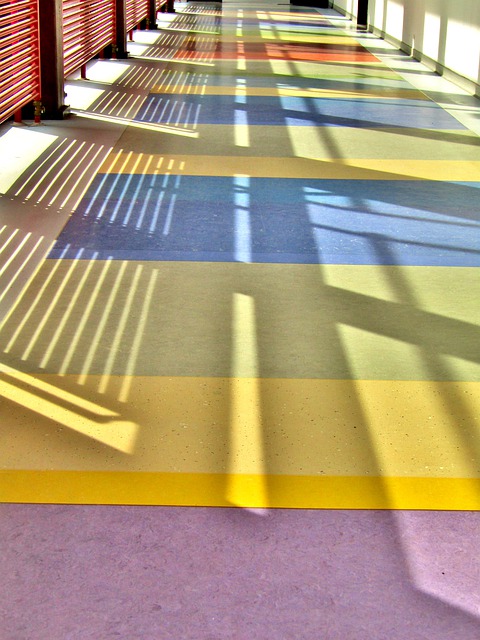Linoleum

|
Linoleum (usually abbreviated to ‘Lino’) is a traditional, smooth, seamless floor covering that is made by combining linseed oil, rosin (solid pine resin), flax, cork flour, wood flour, pigments and other ingredients. The name is a combination of two Latin words: linum (flax) and oleum (oil). During the manufacturing process, the oil is oxidised, a process that is aided by heating and which makes the oil solidify into a resilient, tough sheet.
The process of combining renewable, natural ingredients and pressing them onto a canvas backing to form sheets was invented in England by Frederick Walton in 1860. By 1869, the product had become so popular that Walton began exporting to Europe and the US. He continued to refine the process right up to the early 20th century when he invented an inlay machine that could produce patterned linoleum which proved to be extremely durable.
From its invention right up to the 1960s, linoleum was a popular floor covering which, being seamless, provided a surface that could be hygienic, easy to lay and easy to clean. Originally used for hallways and corridors, it soon spread to kitchens, bathrooms and even living rooms.
Lino is still made today but by a fast-tracked process. However, it is not made in the same quantities and has been largely superseded by synthetic floor coverings such as vinyl and wood laminates. Vinyl has become very popular and has around the same flexibility and durability, but it is less flammable and is supplied in colours which can be brighter and more translucent.
Another differentiator is that while linoleum has the design embedded throughout its constituent materials, modern vinyl coverings have three layers, one of which is an image layer which can carry a pattern or representation of stone, wood etc. Linoleum may also require a protective seam sealant to avoid water penetration.
Despite falling sales since the late 1960s, linoleum sales started to rise in the first two decades of the 21st century. In the UK, it is chiefly manufactured under the trade name of Marmoleum by Kirkaldy-based Forbo Nairn. Hailed as CO2 neutral from cradle to grave, it contains 97% natural raw materials, 72% rapidly renewable and 43% recycled content. It is available in a range of colours and designs which include marble and concrete.
Benefits of linoleum.
- Environment friendly.
- Low VOC content.
- Provides a cushioned, relatively comfortable floor.
- Water resistant.
- Easy to clean.
- Durable.
- Relatively easy installation, especially in tile format.
- Availability in a variety of colours and patterns.
- Continuous colour can mean dents and scrapes are less conspicuous.
[edit] Related articles on Designing Buildings Wiki
- Ash or oak wood flooring.
- Cork flooring.
- Domestic floors: Part 1: Construction, insulation and damp proofing.
- Floor definition.
- Flooring defects.
- How to fit carpet.
- Insulation for ground floors.
- Raised floor.
- Resilient Floor Covering Institute.
- Resilient flooring.
- Resin flooring.
- Rubber flooring.
- Screed.
- Separating floor.
- Sprung floor.
- Terrazzo.
- The Differences Between Engineered Flooring and Solid Hardwood Flooring.
- Types of carpet.
- Types of floor.
Featured articles and news
The UK's Modern Industrial Strategy: A 10 year plan
Previous consultation criticism, current key elements and general support with some persisting reservations.
Building Safety Regulator reforms
New roles, new staff and a new fast track service pave the way for a single construction regulator.
Architectural Technologist CPDs and Communications
CIAT CPD… and how you can do it!
Cooling centres and cool spaces
Managing extreme heat in cities by directing the public to places for heat stress relief and water sources.
Winter gardens: A brief history and warm variations
Extending the season with glass in different forms and terms.
Restoring Great Yarmouth's Winter Gardens
Transforming one of the least sustainable constructions imaginable.
Construction Skills Mission Board launch sector drive
Newly formed government and industry collaboration set strategy for recruiting an additional 100,000 construction workers a year.
New Architects Code comes into effect in September 2025
ARB Architects Code of Conduct and Practice available with ongoing consultation regarding guidance.
Welsh Skills Body (Medr) launches ambitious plan
The new skills body brings together funding and regulation of tertiary education and research for the devolved nation.
Paul Gandy FCIOB announced as next CIOB President
Former Tilbury Douglas CEO takes helm.
UK Infrastructure: A 10 Year Strategy. In brief with reactions
With the National Infrastructure and Service Transformation Authority (NISTA).
Ebenezer Howard: inventor of the garden city. Book review.
The Grenfell Tower fire, eight years on
A time to pause and reflect as Dubai tower block fire reported just before anniversary.
Airtightness Topic Guide BSRIA TG 27/2025
Explaining the basics of airtightness, what it is, why it's important, when it's required and how it's carried out.
Construction contract awards hit lowest point of 2025
Plummeting for second consecutive month, intensifying concerns for housing and infrastructure goals.
Understanding Mental Health in the Built Environment 2025
Examining the state of mental health in construction, shedding light on levels of stress, anxiety and depression.





















